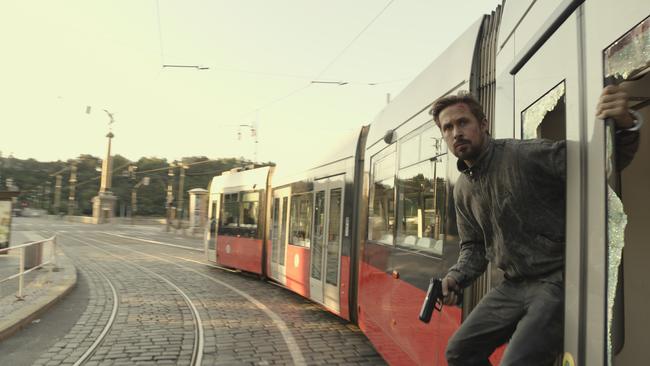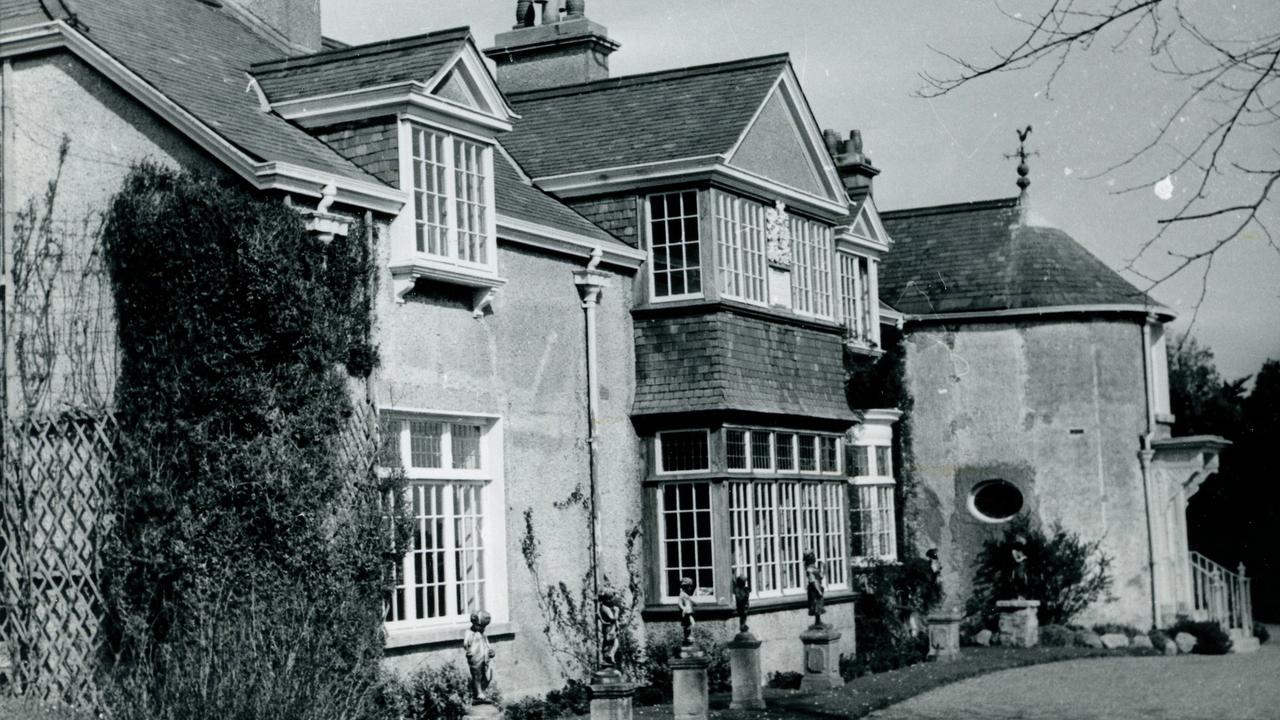The Gray Man, CIA caper third time lucky
The Gray Man spent time in production limbo, with Brad Pitt first cast as Court Gentry, then, in a gender switch, Charlize Theron. Then Ryan Gosling stepped in.

The Gray Man (MA15+)
Netflix
★★★½
With a budget of $US200m ($293m), the spy v spy thriller-comedy The Gray Man is one of the most expensive films Netflix has made. Whether the investment pays off for the streaming giant is for digital algorithms to decide, but for flesh-and-blood viewers it is a highly enjoyable, playfully funny espionage caper.
A quick look at the cast and crew starts to explain that price tag. Sibling directors Anthony and Joe Russo have made four Captain America-Avengers movies for Marvel, each one a money-spinner.
The casting highlight is Captain America, aka Chris Evans, as Lloyd Hansen, who does the blackest of black ops for the CIA.
His “locate and destroy” target is another CIA assassin, Court Gentry (Oscar nominee Ryan Gosling), who has some information on a data drive that is bad for the agency.
During one of their waggish meetings, the tightly moustachioed Lloyd tells “Ken Doll” Court they are rather alike, except for “your childish sense of morality and $8 haircut”. And while I think Gosling would still look good after a kitchen bowl haircut, it’s a fair point to make. Court, codenamed Six (“007 was taken,” he explains), is a Gray Man, someone who works on the murkier side of the CIA ledger. Lloyd is even greyer (as we would spell it). “I can do what the agency can’t,’’ he says.
Yet at the end of the day each man is paid to do the same job – kill people – by the same government authority.
Lloyd describes his business as “Hansen Government Services”. Indeed if the roles were reversed at any time, with Court hired to eliminate Lloyd, neither would be surprised.
It is a lot of fun to see Gosling and Evans in unfamiliar roles. The script, co-written by Joe Russo and regular Russo collaborators Christopher Markus and Stephen McFeely, is quick-witted and not afraid to poke fun at itself and its antecedents, such as the James Bond movies.
“Oh my god!’’ Lloyd says with a loud sigh at a certain point that occurs in every guns blazing film ever made. “How hard is it to shoot somebody?”
The two leads are well supported by Billy Bob Thornton as Donald Fitzroy, an assassin talent scout for the CIA, and Ana de Armas as a regular CIA agent.
That moral sense that Lloyd sees as a weak spot goes to Court’s concern for Fitzroy’s young niece (Julia Butters). We learn more about Court’s past in deftly timed backstory moments. Lloyd, on the other hand, thinks killing a kid is part of a day’s work.
Fine Australian actor Callan Mulvey, who has worked with the Russos in the Avengers universe, has a brief but strong role. The other Australian connection is cinematographer Stephen F. Windon, who has filmed four Fast & Furious movies, including the upcoming Fast X.
He brings that high-octane skill-set to this 125-minute film, especially in one thrilling sequence that shows why it is unwise to fire a gun inside an aircraft.
This movie is based on the best-selling 2009 novel of the same name by American writer Mark Greaney, who also co-wrote Tom Clancy’s final novels.
The adaptation spent time in production limbo, with Brad Pitt first cast as Court Gentry, then, in a gender switch, Charlize Theron. Neither came to be. In the meantime, Greaney wrote nine more Gray Man novels, so there is a good chance this movie is the first of a series. I hope that is the case.
It’s not as hard-hitting or as mischievous as another secret service drama, the Slow Horses series now available on Apple TV+, based on the novels by Mick Herron, but it’s still well worth watching.
-
Don’t Make Me Go (MA15+)
Amazon Prime
★★★½
Why is New Zealand the location for a movie about an American road trip? The answer is a common one of our times: Covid-19.
When Don’t Make Me Go, directed by Hannah Marks and written by Vera Herbert, was set to start filming early last year, New Zealand was free of Covid cases.
And as the lead actor, John Cho, was already there making the Netflix sci-fi series Cowboy Bebop, the filmmakers decided it was easier to come to him.
So it is that a father, daughter and wood-panelled station wagon drama that moves from California to Florida was shot at the other end of the world. A Texas casino? Christchurch has one that will do the job. A Florida beach favoured by nudists? Auckland can lend a hand there. A motel with a guitar-shaped swimming pool? No problem. Dive right in.
The New Zealand setting also means a few Kiwis are in the cast and crew. The director, in an interview I read, lavished praise on NZ production designer Felicity Abbott for “making our New Zealand settings reflect an American aesthetic”.
As I watched I thought of Baz Luhrmann’s spectacular Elvis being filmed in Queensland. We do live in interesting times.
Don’t Make Me Go asks a question that has been around far longer than Covid: when is it OK for a parent to keep something from their child?
Max (Cho) is a 40-something white-collar worker in California. He is sole parent of 15-year-old Wally (an impressive Mia Isaac). Her mother, his wife, left them when Wally was a baby.
Wally, like every teenager, doesn’t tell her father everything about her life, including the extent of her relationship with her “unofficial” boyfriend.
Yet as this 110-minute movie develops, it becomes clear that Max is the one covering up the most secrets. The one that sets up the film, and the road trip, is that he has been diagnosed with bone cancer.
If he undergoes surgery, he has a 20 per cent chance of survival. If he refuses surgery he’ll be dead within a year. He decides on the latter.
“My daughter’s not ready for me to be dead in … I don’t know … a week,’’ he tells his “booty call” girlfriend, who he also has not told Wally about.
He tells his daughter the destination, New Orleans, is so he can attend his college reunion. The incentive for her is that he will teach her to drive en route.
He’s the sort of man who has named his old station wagon. This “not a Tesla” is Jerry. As his daughter climbs in, she jokes that Jerry’s second name is Atric.
The father-daughter chemistry between the two stars is wonderful. There’s a beautiful scene where they dance together in a jazz bar in New Orleans.
Max also does not tell Wally that the real purpose of the trip is to meet her mother, who left him (and her) for his college friend Dale (New Zealand actor Jemaine Clement).
While Wally does typical teenage things during the trip, often involving boys, it’s her father who has the real explaining to do.
As they become closer, he reveals more about his past. Talking about his marriage, he says, “I went out, I got drunk and that was that.” Those final four words are sadly perfect.
Some viewers may find it hard to believe any parent would keep so much, particularly their own death sentence, from their teenage child.
That may be so. Yet personally I find the gradual coming together of adult and near-adult worlds believable and moving.
Those two worlds align towards the end in a huge, devastating twist. What that is, however, is a secret I must keep.



